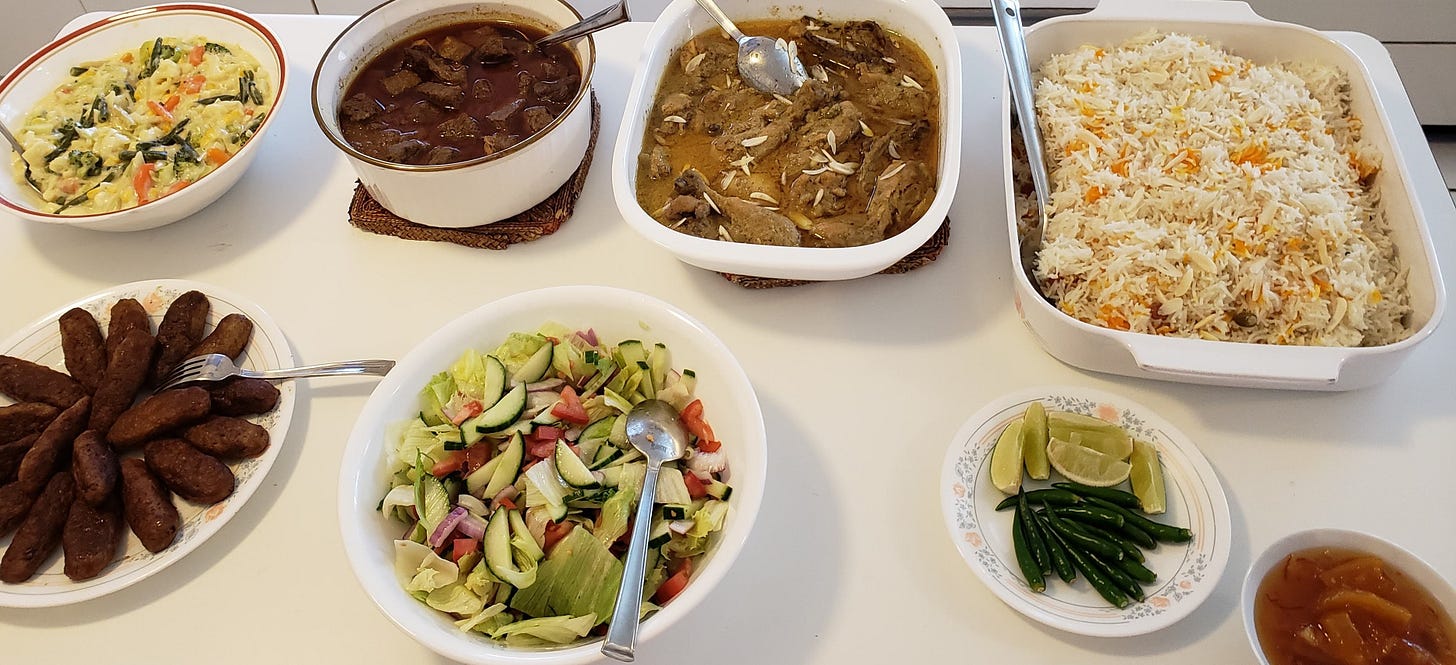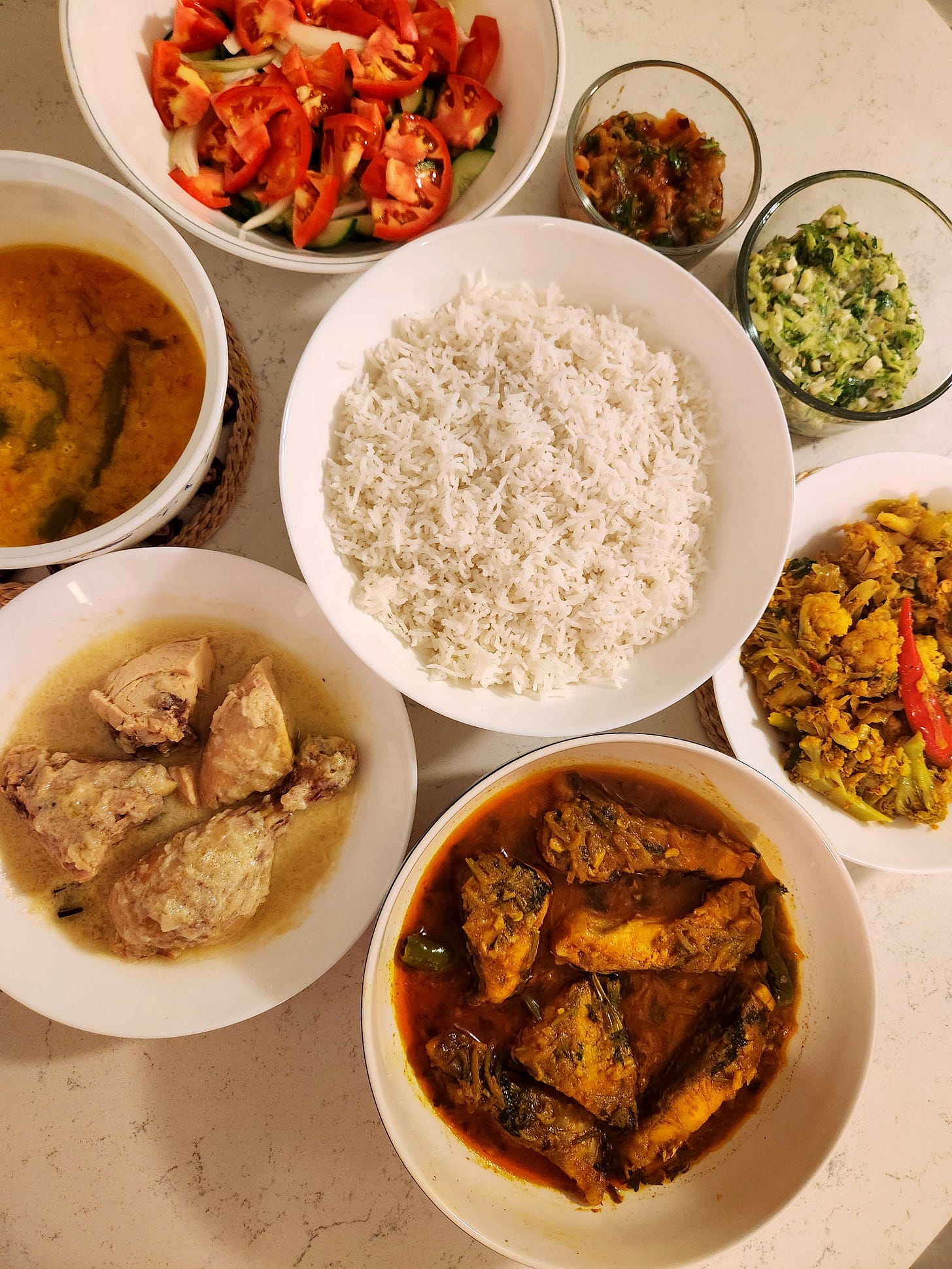When I first introduced my husband to Bangladeshi food, he did what a lot of non-Bangladeshis do. He mixed everything together and ate the myriad of dishes together as one. He was thoroughly enjoying himself, so I let him enjoy his meal (because truly, that’s the most important thing) but my little Bangladeshi heart needed to walk him through some of our customs on how to eat a Bangladeshi meal.
And you lucky reader can get this crash course too.
A Bangladeshi meal doesn’t have set courses like at a restaurant. There is no distinction between appetizers and main courses, as everything is traditionally served all at once, family style, and relatively informally. But there is an order that dishes are meant to be enjoyed and eaten.
There are also two broad types of traditional fare in Bangladeshi cuisine. The first is what is considered everyday food, or accompaniments to dal-bhaat (dal and rice). The second is the rich Mughlai influenced dishes like polao, biryani, roasts, kababs, and more that are served for company, and at holidays, celebrations and weddings.
You are not supposed to mix dal-bhaat dishes with Mughlai dishes. So for example, you would not mix dal with biryani (though I have seen someone do this before, and if you think it tastes good, who am I to judge?)
For the everyday Bangladeshi meal, the order of eating is intended to flow from the lighter foods to the heavier foods - from bhorta, to vegetable dishes, fish, meat, and ending the meal with dal.
Bhorta-Bhaji-Maach-Mangsho-Dal (BBMMD if you need an acronym).
Take a little bit of one dish, mix with rice, and work your way through each item on your plate, accompanied with the crunch from a simple side salad, or fresh green chilies, onions and lemon.
A short disclaimer: This is an example of a standard Bangladeshi meal, and some meals can be much bigger and more elaborate, and some can be pared down to just the basic dal-bhaat. There are other items that aren’t mentioned here. For example, shutki or dried fish will need it’s own post, there are numerous accompaniments that can be enjoyed on the side, and I haven’t even mentioned the famous Bengali sweets yet.
Let’s dive a bit more into what this looks like. (And a side note here: the order that Bangladeshis eat a meal is different from the order that West Bengalis in India eat their meals. There are regional differences in the dishes served and consumed.)
Bhorta
Bhorta is always the opener to a Bangladeshi meal. This is usually a mash-like preparation of vegetables, peels, or leafy greens that is combined with fresh or dried chilies, onions, cilantro, salt and mustard oil or ghee. This is often a spicy, tangy, or fresh palate opening blend that is mixed with rice. There are hundreds of variations of bhorta, including potato, tomato, beans, lau peels, eggplant, and more.
Bhaji, Shaak, Shobji and Other Vegetable Dishes
Next in the order are the vegetable dishes. There may be one, or there may be a few depending on the cook, and the occasion. There are a few different types of vegetable dishes in this category.
Bhaji
Bhaji is most similar to a stir fry. This is where vegetables are lightly spiced and cooked with oil and onions until soft or brown. Truly almost any type of vegetable can be made into a bhaji, and popular bhajis include cabbage, potato, eggplant, broccoli, okra, chayote, etc.
Shaak
Shaak refers to any type of leaf. This includes palong shaak (spinach), laal shaak (red spinach), pui shaak (malabar spinach), lau shaak (leaf of the bottle gourd), among others. Shaak can be prepared like a bhaji alone, or paired with prawns, shrimp or other fish. If it’s prepared with fish, then the order of eating the shaak moves to the fish category.
Shobji or Torkari
A vegetable dish that isn’t a bhaji or a shaak is usually classified as a shobji or torkari (these words just mean vegetables). As bhajis are dryer, a shobji or torkari will have more of a gravy or sauce to the vegetable dish. These are also usually a mix of different vegetables, like potatoes, carrots, cabbage, green beans, peas, peppers, etc. which make them great dishes to prepare when you need to clean the fridge out.
Maach
After the bhorta and bhajis come maach, or the fish items. If you couldn’t tell by the little fish in our logo, fish is central to Bangladeshi culture.
There is a common saying maache bhaate Bangali, or fish and rice is what makes a Bengali.
Bangladesh has an abundance of rivers crisscrossing through the country, which was the source of a massive fish supply for the country. Fish makes up 60% of Bangladeshis’ animal protein intake, and is often the focus of the meal. Fish in Bangladesh includes hundreds of native species, like the especially prized ilish or hilsa fish, dried fish known as shutki, and also includes shellfish like chingri maach, or large prawns. Preparation of fish can be bhaja (fried), bhuna (dry curry preparation), jhol (thin/broth like preparation), with malai (cream preparation), or combined with shaak or other vegetables. There are a multitude of ways to prepare maach.
Mangsho
After the maach comes the mangsho, or meat. This can include chicken, lamb, mutton, goat or beef dishes that are prepared in a variety of curries and flavours. Unless it is a special occasion, it’s unlikely that there would be multiple meat dishes at an everyday meal.
Dal
Dal, or lentils, is the final item of a Bangladeshi meal. It is usually prepared in a soup-like consistency (sometimes thick, sometimes thin) and mixed with rice, it is used as the mechanism to clean the plate and ensure that every grain of rice is eaten. If there is a particular dish you liked (often a bhorta or a veggie), this is the time to break the no mixing guideline. Take a little bit more, mix it in with your dal, and clean your plate.
In the next few weeks, we will be starting a series of Bangladeshi Basics and covering a simple and basic preparation for each part of a Bangladeshi meal. For those who are just dabbling into Bangladeshi cuisine, this is a great starting point.
Here’s what we’ll be covering in the next few weeks
Bhorta - Aloo Bhorta (potato bhorta)
Bhaji - Badhakopi and Broccoli Bhaji (cabbage and broccoli bhaji)
Maach - Rui Maach Bhuna (rohu fish bhuna)
Mangsho - Simple Bangladeshi Chicken
Dal - Ghono Dal (thick dal)
Whatever you’re eating this week, moja kore khao (eat with delight, or enjoy your food!)
Mitali





